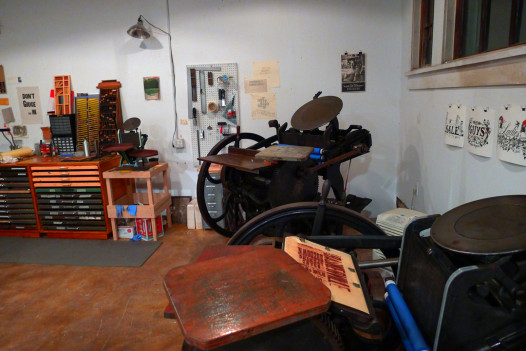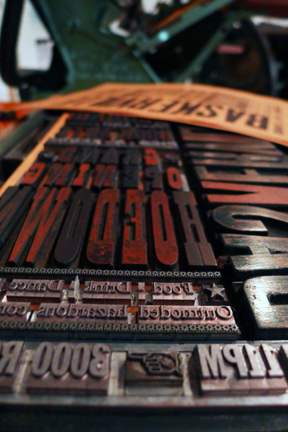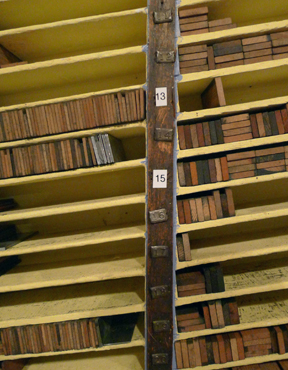Editor’s note: This Saturday, a new letterpress and book arts center is opening in the Inferno Building on Montegut Street, just across the tracks in the Bywater. Baskerville (named after the serif-based typeface) describes itself as a public studio; it will offer shared equipment and workspace to member artists, as well as education opportunities to the broader community. With a wide range of craft making/learning organizations throughout the city (from Press Street to The Community Print Shop to Free School Network and the upcoming St. Claude Lab), classically-inspired letterpress printing has remained off the map, at least on a local level. In a hyper-digital age, photographers are reverting back and seeking refuge in making prints, photoshop-sickened graphic artists are making more screens, and book artists are binding real, cover-to-cover objects with ink in between.
Here, Baskerville Co-Founder Amelia Bird shares with NolaVie why New Orleans didn’t have such a studio and why she had to bring one back.

Baskerville’s three-century-old Chandler & Price platen presses, also called ‘clamshells’ because of how they open and close: The table-top press operates with a lever, the press in the foreground runs off a treadle, and the large press in the corner will be motorized.
Letterpress printing and bookbinding are the essence of tactility: the feel of letters imprinted on a clean sheet; the crank of presses and the taut twang of waxed thread; the fresh scent of ink, glue, and pulp.
Though these traditional crafts were once prolific (every small town had its own letterpress printer), in this era of digital … everything, they’re novelties. That’s probably why the book arts have seen resurgence. Contemporary design reeks of old print technology and typography, the book is now a sculptural art object, letterpress printed wedding invitations are all the rage on the blogosphere, and almost every major city (San Francisco, Seattle, Minneapolis, New York, Chicago, Philadelphia, Salt Lake City, Portland) and even many small ones (Asheville, Sandy Spring, Tuscaloosa, Iowa City, Rosendale, Telluride, Memphis, Rochester) have a Center for the Book, sizeable art studio, or major university that offers regular coursework in bookbinding, letterpress printing, papermaking, and artist’s books.
But not New Orleans.
This void is not entirely surprising. Even in a city with more “normal” weather, history, and infrastructure, the equipment required for bookmaking and letterpress printing is persnickety, cumbersome, old, and expensive. Outfitting and maintaining a shop can be difficult for a professional printer or binder, much less an interdisciplinary artist or anyone living below sea level.
At the same time, New Orleans and the book arts seem like they should be lovers. Who lusts after lavish ornamentation, handcrafts, aesthetics, and antiquated processes more than we do?

Hand-set type, locked up after printing the flyer for the Grand Opening Hoedown. Every letter and each space is an individual piece of wood or metal.
Enter Baskerville: a brand new, classically-inspired letterpress printing and book arts studio in New Orleans. The mission of Baskerville is to provide its member artists with quality equipment; a safe, clean, and inspiring studio environment; and creative and professional opportunities.
In October, we began outfitting a studio space. With only four founding members and an 800-square-foot studio, we are still a young organization, but progress has been steady. Rise and Shine Letterpress in Alexandria donated a large, century-old Chandler & Price press, two other presses followed soon after, and we have been adding to our collection of wood and lead type.
I got into bookbinding and printing eight years ago when I was supposed to be writing and having a hard go of it. Something about the physicality of the book arts spoke to me. I started taking classes and, eventually, making books with content. I liked that there were non-textual options for creating meaning —images, structure, sequence, form, materials — and that not all of these were under my control at all times. I liked learning about the history and context of the codex. I identified with how self-aware the book is in the digital era. But even more than all that, the process of letterpress printing and bookbinding slowed and focused my thought, rooted the claptrap of creativity in a physical process that had clear steps, actual problems to solve and decisions to make, and a real-life finished product. Writing felt natural to me for the first time.
Another thing I like about letterpress and book arts is that people approach from so many different angles: zines, graphic design, gardening, publishing, printmaking, woodworking, literature, library science, chemistry, mechanical engineering, poetry. We are a motley crew at Baskerville: a noise musician who used to produce crazy music posters at Hatch Show Print in Nashville, an architectural historian and preservationist, and a multi-media artist and printmaking alumnus from UNO. Once our shop is outfitted, we hope to expand our numbers into an increasingly diverse member base.

Baskerville is still building on its supply of leading, type, and furniture. This is a cabinet of reglets, which are thin slivers of wood used in locking up type for printing.
As Baskerville grows, we must grapple with the difficulty of maintaining our equipment in a humid environment and ensuring safe use of our powerful machinery. And there are many details still to be worked out regarding our unique operating model; Baskerville is a collective studio that houses both members’ private equipment and jointly-acquired equipment — public access to all of which will be provided through structured events (classes, workshops, and community partnerships). But that’s the goal: to make the traditional craft processes of letterpress printing and bookbinding accessible to everyone, and for Baskerville to be a community resource and destination for anyone excited by inky fingers, folded paper, and outmoded technology.
Baskerville opens its studio doors for the first time on February 8, with a Grand Opening Hoedown from 8 to 11 p.m. at 3000 Royal St.
Amelia Bird is the co-founder of Baskerville. Her artist’s books can be found in more than 40 libraries nationwide, she teaches and publishes and presents periodically, and she is the communications and development fellow at Edible Schoolyard New Orleans.
This Saturday, Bakserville is opening its doors for a Hoedown in the space. The event is free to the public, with food, drinks, music, and “outmoded, hazardous contraptions galore.”
 NOLAbeings Multimedia artist Claire Bangser created NOLAbeings as a portrait-based story project that marries...
NOLAbeings Multimedia artist Claire Bangser created NOLAbeings as a portrait-based story project that marries...  Voodoo in New Orleans: Reviving history: New Orleans fortune telling This article takes a deep dive into the history of Voodoo in New Orleans, its hybridization with Catholicism, and its present-day place in the city's culture. The author visits fortune-tellers in the French Quarter, using their guidance as a tool for introspection rather than a deterministic predictor of the future. Through her experiences in New Orleans, the author feels a mystical connection to both the past and the future.
Voodoo in New Orleans: Reviving history: New Orleans fortune telling This article takes a deep dive into the history of Voodoo in New Orleans, its hybridization with Catholicism, and its present-day place in the city's culture. The author visits fortune-tellers in the French Quarter, using their guidance as a tool for introspection rather than a deterministic predictor of the future. Through her experiences in New Orleans, the author feels a mystical connection to both the past and the future. 